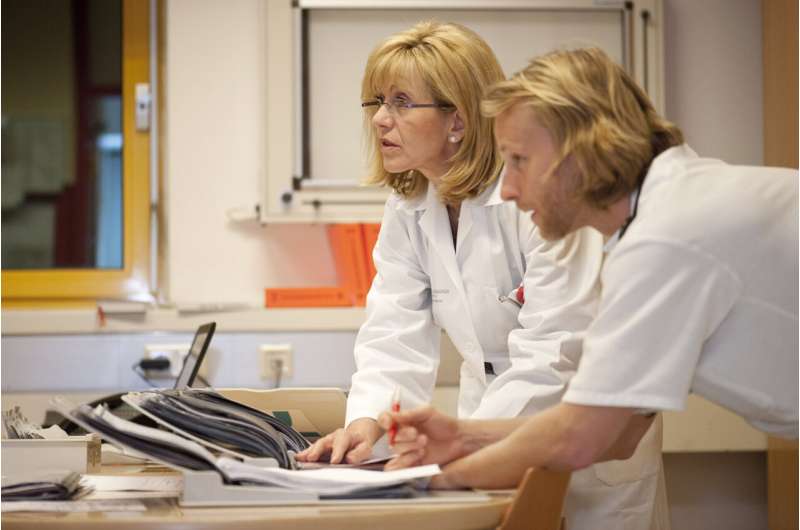Nerve tumor in children: Better tolerable chemotherapy without loss of efficacy


The initial chemotherapy of aggressive childhood nerve tumors, so-called high-risk neuroblastomas, is crucial for ultimate survival. It has now been shown that the chemotherapy regimen used by the European Neuroblastoma Study Group is equally efficacious but better tolerated than a highly effective regimen from the US. This was the conclusion of an international trial coordinated by St. Anna Children’s Cancer Research Institute. The study was published in the prestigious Journal of Clinical Oncology.
For particularly aggressive nerve tumors in children, so-called high-risk neuroblastomas, various combination chemotherapies are used with the intention to shrink the tumor before surgery (i.e., induction chemotherapy). The efficacy of such an induction therapy significantly impacts the chances of survival. The European Neuroblastoma Study Group of the International Society of Pediatric Oncology (SIOPEN), has now compared two of the most effective combination therapies in an international study, coordinated by St. Anna Children’s Cancer Research Institute (St. Anna CCRI). The result: equal efficacy, but significantly lower rates of side effects with the therapy regimen considered the standard of the European Neuroblastoma Group SIOPEN.
“With the European rCOJEC regimen, high-grade vomiting, nausea, diarrhea, infections and stomatitis were significantly lower than in the US reference group. We will therefore implement it as a standard of care for high-risk neuroblastoma,” says Prof. Ruth Ladenstein, MD, MBA, cPM, senior author of the study and head of the Studies & Statistics for Integrated Research and Projects (S2IRP) group at St. Anna CCRI.
Equal efficacy, less side effects The study team compared the treatment regimen of the renowned Memorial Sloan Kettering Cancer Center, i.e., MSKCC-N5 regimen, which has the best efficacy results to date, with the so-called rCOJEC regimen (see also “About the Study”), the standard SIOPEN treatment in Europe. In the present international phase III study, a total of 630 patients were randomly assigned to one of the two regimens. Prof. Ladenstein and her international colleagues intended to evaluate whether the MSKCC-N5 regimen improves the response of tumor metastases (metastatic complete response) compared with rCOJEC. Furthermore, the clinicians investigated whether MSKCC-N5 therapy reduces the likelihood of relapse within three years (3-year event-free survival), compared with the rCOJEC regimen. Neither was the case. This study showed that the efficacy did not significantly differ between the two treatment regimens. However, the rate of high-grade (grade 3-4), acute adverse events was significantly higher with the MSKCC-N5 regimen.
According to Prof. Ladenstein, further studies should now examine the efficacy of immunotherapies in addition to the rCOJEC regimen, given that only about 60 and 65 percent of children receiving the rCOJEC and -MSKCC-N5 regimens, respectively, are still alive after three years. Prof. Ladenstein comments, “We urgently need to further improve the survival outcome. For example, the combination of chemotherapy with anti-GD2 antibodies is very promising—a combination that will be tested in randomized trials by SIOPEN and others.”
High need for randomized trials Thanks to continuously improving therapies, an increasingly larger number of children with high-risk neuroblastoma are already surviving their disease nowadays. Furthermore, those who survive have a long life expectancy. “For this reason it is even more important today to also investigate sequelae resulting from intensive chemotherapies,” explains Prof. Ladenstein.”Our study is only the fourth randomized trial investigating induction therapies in high-risk neuroblastoma. That’s because randomized clinical trials require a lot of organizational effort at the international level due to small case numbers in each participating country. But they are essential for providing the best treatment for childhood cancer patients,” adds Prof. Ladenstein.
About the studyThe SIOPEN international randomized phase III HR-NBL1.5 trial included a total of 630 subjects. The median age was 3.2 years. The study included children or adolescents between one and 20 years of age with stage 4 neuroblastoma older than 12 months or infants younger than one year of age with stage 4S and MYCN amplification. Study participants were randomly assigned in a 1:1 ratio to the rCOJEC (cisplatin, vincristine, etoposide, cyclophosphamide, and carboplatin) or MSKCC-N5 regimen (cyclophosphamide, doxorubicin, vincristine, and cisplatin). Induction therapy with one of these regimens was followed by tumor surgery, high-dose chemotherapy (busulphan, melphalan), radiotherapy, and isotretionin combined with immunotherapy with dinutuximab beta. Co-primary study endpoints were metastatic complete response and 3-year event-free survival.
Source: Read Full Article




